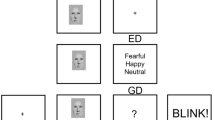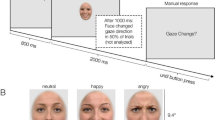Abstract
The N170 ERP component is a central neural marker of early face perception usually thought to reflect holistic processing. However, it is also highly sensitive to eyes presented in isolation and to fixation on the eyes within a full face. The lateral inhibition face template and eye detector (LIFTED) model (Nemrodov et al. in NeuroImage 97:81–94, 2014) integrates these views by proposing a neural inhibition mechanism that perceptually glues features into a whole, in parallel to the activity of an eye detector that accounts for the eye sensitivity. The LIFTED model was derived from a large number of results obtained with intact and eyeless faces presented upright and inverted. The present study provided a control condition to the original design by replacing eyeless with mouthless faces, hereby enabling testing of specific predictions derived from the model. Using the same gaze-contingent approach, we replicated the N170 eye sensitivity regardless of face orientation. Furthermore, when eyes were fixated in upright faces, the N170 was larger for mouthless compared to intact faces, while inverted mouthless faces elicited smaller amplitude than intact inverted faces when fixation was on the mouth and nose. The results are largely in line with the LIFTED model, in particular with the idea of an inhibition mechanism involved in holistic processing of upright faces and the lack of such inhibition in processing inverted faces. Some modifications to the original model are also proposed based on these results.




Similar content being viewed by others
References
Allison T, Puce A, McCarthy G (2002) Category-sensitive excitatory and inhibitory processes in human extrastriate cortex. J Neurophysiol 88(5):2864–2868
Bentin S, Allison T, Puce A, Perez E, McCarthy G (1996) Electrophysiological studies of face perception in humans. J Cogn Neurosci 8:551–565
de Haan M, Pascalis O, Johnson MH (2002) Specialization of neural mechanisms underlying face recognition in human infants. J Cogn Neurosci 14(2):1–11
de Lissa P, McArthur G, Hawelka S, Palermo R, Mahajan Y, Hutzler F (2014) Fixation location on upright and inverted faces modulates the N170. Neuropsychologia 57, 1–11
Delorme A, Makeig S (2004) EEGLAB: an open source toolbox for analysis of single-trial EEG dynamics including independent component analysis. J Neurosci Methods 134(1):9–21
Eimer M (1998) Does the face-specific N170 component reflect the activity of a specialized eye processor? Neuroreport 9(1399019440):2945–2948
Eimer M (2000a) Effects of face inversion on the structural encoding and recognition of faces. Evidence from event-related brain potentials. Brain Res Cogn Brain Res 10(1–2):145–158
Eimer M (2000b) The face-specific N170 component reflects late stages in the structural encoding of faces. Neuroreport 11(10):2319–2324
Eimer M (2011) The face-sensitive N170 component of the event-related brain potential. In: Calder AJ, Rhodes G, Johnson MH and Haxby JV (eds) The oxford handbook of face perception. Oxford University Press, Oxford, pp. 329–344
Engell AD, McCarthy G (2014) Face, eye, and body selective responses in fusiform gyrus and adjacent cortex: an intracranial EEG study. Front Hum Neurosci 8:642
Freiwald WA, Tsao DY, Livingstone MS (2009) A face feature space in the macaque temporal lobe. Nat Neurosci 12(9):1187–1196
George N, Evans J, Fiori N, Davidoff J, Renault B (1996) Brain events related to normal and moderetately scrambled faces. Brain Res Cogn Brain Res 4(2):65–76
Itier RJ, Neath-Tavares KN (2017) Effects of task demands on the early neural processing of fearful and happy facial expressions. Brain Res 1663:38–50
Itier RJ, Taylor MJ (2002) Inversion and contrast polarity reversal affect both encoding and recognition processes of unfamiliar faces: a repetition study using ERPs. NeuroImage 15(2):353–372
Itier RJ, Latinus M, Taylor MJ (2006) Face, eye and object early processing: what is the face specificity? NeuroImage 29(2):667–676
Itier RJ, Alain C, Sedore K, McIntosh AR (2007) Early face processing specificity: it’s in the eyes! J Cogn Neurosci 19(11):1815–1826
Itier RJ, Van Roon P, Alain C (2011) Species sensitivity of early face eye processing NeuroImage 54(1):705–713
Jacques C, Rossion B (2009) The initial representation of individual faces in the right occipito-temporal cortex is holistic: electrophysiological evidence from the composite face illusion. J Vision 9(6):8, 1–16
Kloth N, Itier RJ, Schweinberger SR (2013) Combined effects of inversion and feature removal on N170 responses elicited by faces and car fronts. Brain Cogn 81(3):321–328
Maurer D, Le Grand R, Mondloch CJ (2002) The many faces of configural processing. Trends Cogn Sci 6(6):255–260
McPartland J, Cheung CH, Perszyk D, Mayes LC (2010) Face-related ERPs are modulated by point of gaze. Neuropsychologia 48(12):3657–3660
Neath KN, Itier RJ (2015) Fixation to features and neural processing of facial expressions in a gender discrimination task. Brain Cogn 99:97–111
Neath-Tavares KN, Itier RJ (2016) Neural processing of fearful and happy facial expressions during emotion-relevant and emotion-irrelevant tasks: a fixation-to-feature approach. Biol Psychol 119:122–140
Nemrodov D, Itier RJ (2011) The role of eyes in early face processing: a rapid adaptation study of the inversion effect. Br J Psychol 102(4):783–798
Nemrodov D, Anderson T, Preston FF, Itier RJ (2014) Early sensitivity for eyes within faces: a new neuronal account of holistic and featural processing. NeuroImage 97, 81–94
Rossion B (2009) Distinguishing the cause and consequence of face inversion: the perceptual field hypothesis. Acta Physiol 132(3):300–312
Rossion B, Jacques C (2012) The N170: understanding the time course of face perception in the human brain. In: Luck SJ, and Kappenman ES (eds) The oxford handbook of event-related potential components. Oxford university Press, Oxford, pp. 115–141
Rossion B, Taubert J (2017) Commentary: the code for facial identity in the primate brain. Front Hum Neurosci 2017 11:550
Rossion B, Delvenne JF, Debatisse D, Goffaux V, Bruyer R, Crommelinck M et al (1999) Spatio-temporal localization of the face inversion effect: an event-related potentials study. Biol Psychol 50(399388900):173–189
Rossion B, Gauthier I, Tarr MJ, Despland P, Bruyer R, Linotte S et al (2000) The N170 occipito-temporal component is delayed and enhanced to inverted faces but not to inverted objects: an electrophysiological account of face-specific processes in the human brain. Neuroreport 11(120147456):69–74
Rousselet GA, Ince RA, van Rijsbergen NJ, Schyns PG (2014) Eye coding mechanisms in early human face event-related potentials. J Vis 14(13):1–24
Sadeh B, Yovel G (2010) Why is the N170 enhanced for inverted faces? An ERP competition experiment. NeuroImage 53(2), 782–789
Sagiv N, Bentin S (2001) Structural encoding of human and schematic faces: holistic and part-based processes. J Cogn Neurosci 13(7):937–951
Schyns PG, Jentzsch I, Johnson M, Schweinberger SR, Gosselin F (2003) A principled method for determining the functionality of brain responses. Neuroreport 14:1665–1669
Shepherd J, Davies G, Ellis H (1981) Studies of cue saliency. In: Davies G, Ellis HD, Shepherd J (eds) Perceiving and remembering faces. Academic Press, New York, pp 105–131
Tanaka JW, Gordon I (2011) Features, configuration, and holistic face processing. In: Calder AJ, Rhodes G, Johnson MJ, Haxby JV (eds) The Oxford handbook of face perception. Oxford University Press, New York, pp 177–194
Taylor MJ, Edmonds GE, McCarthy G, Allison T (2001) Eyes first! eye processing develops before face processing in children. Neuroreport 12(8):1671–1676
Wang Y, Fujita I, Murayama Y (2000) Neuronal mechanisms of selectivity for object features revealed by blocking inhibition in inferotemporal cortex. Nat Neurosci 3(8):807–813
Wiese H, Stahl J, Schweinberger SR (2009) Configural processing of other-race faces is delayed but not decreased. Biol Psychol 81(2):103–109
Zerouali Y, Lina JM, Jemel B (2013) Optimal eye-gaze fixation position for face-related neural responses. PloS ONE 8(6):e60128
Acknowledgements
This work was supported by the Natural Sciences and Engineering Research Council of Canada (NSERC Discovery Grants #418431); the Ontario government (Early Researcher Award, ER11-08-172); the Canada Foundation for Innovation (Grant #213322); and the Canada Research Chairs program (Grants #213322 and #230407) to RJI. We would also like to thank Marina Ren for help with testing, supported by an NSERC Undergraduate Studies Research Award (USRA).
Author information
Authors and Affiliations
Corresponding author
Additional information
Handling editor: Micah M. Murray.
Electronic supplementary material
Below is the link to the electronic supplementary material.
Rights and permissions
About this article
Cite this article
Itier, R.J., Preston, F. Increased Early Sensitivity to Eyes in Mouthless Faces: In Support of the LIFTED Model of Early Face Processing. Brain Topogr 31, 972–984 (2018). https://doi.org/10.1007/s10548-018-0663-6
Received:
Accepted:
Published:
Issue Date:
DOI: https://doi.org/10.1007/s10548-018-0663-6




